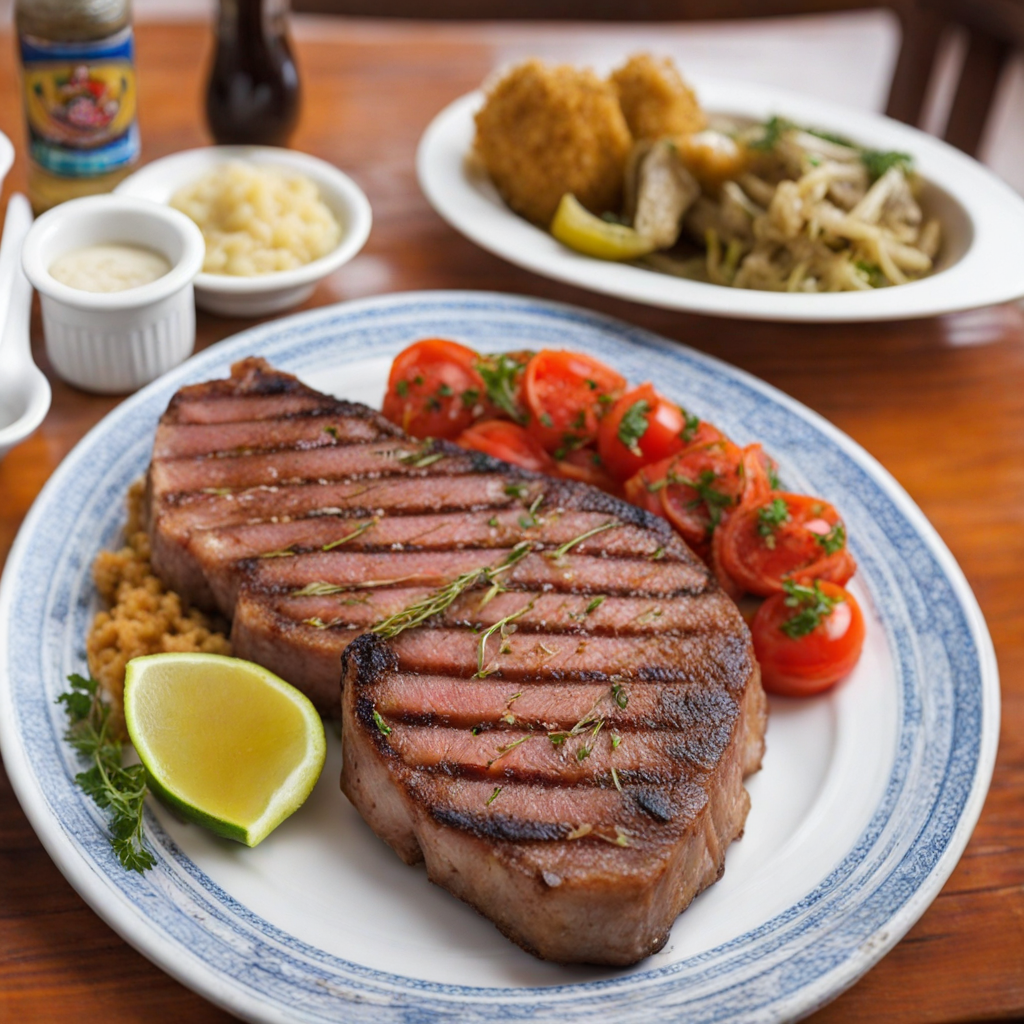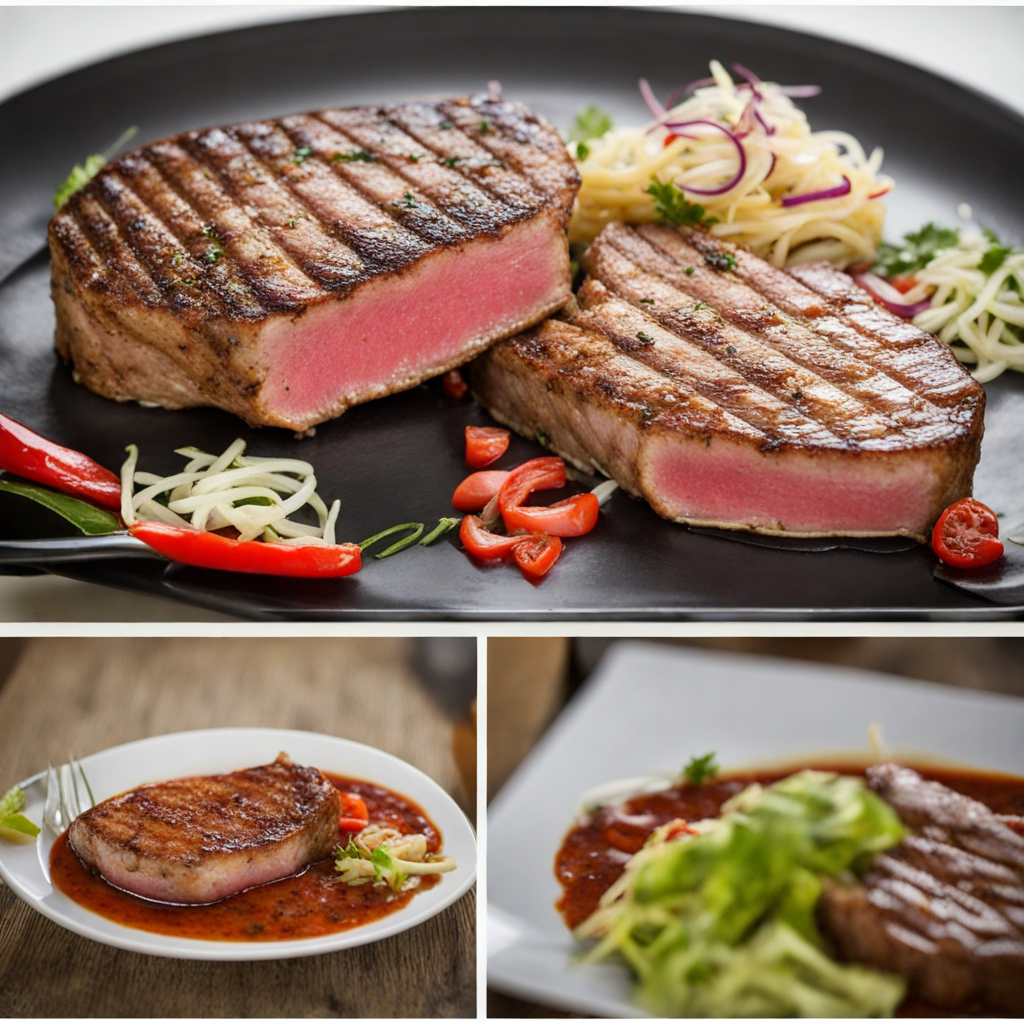Bife de atum
Bife de atum, a popular dish from Cape Verde, showcases the island's rich maritime heritage through its delicious use of fresh tuna. This dish typically features thick, juicy slices of tuna steak that are expertly seasoned with a blend of local spices, often including garlic, onions, and a touch of lemon or lime to enhance the natural flavors of the fish. The preparation may involve grilling or pan-searing the tuna, resulting in a beautifully caramelized exterior while maintaining a tender, succulent center that melts in your mouth. The unique taste of Bife de atum is further elevated by the accompaniment of traditional sides, such as rice, beans, or the local favorite, 'milho', which is a corn-based dish. The combination of the savory tuna and these wholesome sides creates a comforting meal that embodies the essence of Cape Verdean cuisine. Additionally, the dish is often served with a vibrant salad or sautéed vegetables that provide a refreshing contrast to the rich flavors of the fish. What makes Bife de atum a true culinary gem is not just its taste, but also the cultural significance it holds within Cape Verdean society. Enjoying this dish often evokes a sense of community and celebration, whether it’s shared among family at home or served at lively gatherings. As you take your first bite, you'll not only experience the exquisite flavors but also feel the warmth of Cape Verde's vibrant culture and the salty breeze of its beautiful shores.
How It Became This Dish
Bife de Atum: A Culinary Gem of Cape Verde Origins: A Convergence of Cultures Bife de atum, or tuna steak, is a dish that beautifully encapsulates the culinary heritage of Cape Verde, an archipelago located off the northwest coast of Africa. The islands, known for their volcanic landscapes and rich maritime resources, were uninhabited until the Portuguese discovered them in the 15th century. This initial encounter set the stage for a unique cultural melange that would shape the islands' cuisine over centuries. The indigenous peoples of Cape Verde, though few and mostly displaced, had a connection to the sea that would later be reflected in the dishes that emerged. However, the islands’ strategic location along trade routes meant that they became a melting pot of influences from various cultures, particularly Portuguese, African, and later, Brazilian and Caribbean. The Portuguese introduced a range of culinary practices, many of which were adapted to the local environment and available resources. Tuna, a staple in Cape Verdean waters, became an integral part of the local diet. The abundance of this fish made it a natural choice for local dishes, and the preparation methods evolved over time. The term "bife," which means "steak" in Portuguese, signifies the way the fish is often prepared—grilled or seared to create a flavorful and satisfying dish. Cultural Significance: More Than Just a Meal Bife de atum is more than just a dish; it is a symbol of Cape Verdean identity and resilience. The islands’ inhabitants have always had a strong relationship with the sea, relying on fishing not only for sustenance but also as a way of life. Tuna fishing became a communal activity, fostering a sense of unity among the islanders. The preparation and sharing of bife de atum often occurs during family gatherings and festive occasions, reinforcing its role in communal and familial bonds. The dish is often served with sides such as rice, beans, and vegetables, complementing the rich flavors of the grilled tuna. It can also be accompanied by a traditional sauce known as “molho de limão,” made from lemon juice, garlic, and olive oil, which enhances the natural taste of the fish. The simplicity of the ingredients reflects the broader Cape Verdean culinary philosophy, which emphasizes freshness and quality over complexity. In Cape Verde, food is often linked to cultural narratives, and bife de atum is no exception. Traditionally, it represents the islanders' connection to their maritime heritage, evoking a sense of pride in their fishing traditions. During the annual Tuna Festival in São Vicente, for instance, bife de atum takes center stage, showcasing the importance of this dish in celebrations that honor local fishermen and the fishing industry. Development Over Time: A Culinary Evolution As Cape Verdean society evolved, so too did the preparation and presentation of bife de atum. The influence of globalization and the rise of tourism in the late 20th century introduced new culinary techniques and flavors to the islands. Chefs began experimenting with various marinades and spices, incorporating ingredients from other cultures while still honoring traditional methods. In the 21st century, bife de atum has gained recognition beyond the shores of Cape Verde. As Cape Verdean diaspora communities emerged in countries like the United States, Portugal, and France, they carried their culinary traditions with them, leading to a renewed interest in Cape Verdean cuisine. Restaurants in urban areas began to feature bife de atum on their menus, often adapting the dish to local tastes while maintaining its essence. Social media has also played a significant role in popularizing Cape Verdean cuisine, with food bloggers and enthusiasts sharing recipes and stories about traditional dishes like bife de atum. This digital presence has fostered a global appreciation for Cape Verdean culinary traditions, allowing the dish to transcend geographical boundaries. Modern Interpretations: A Global Palette In contemporary culinary settings, bife de atum has experienced a renaissance, with chefs presenting the dish in innovative ways. For instance, fusion cuisine has led to the incorporation of Caribbean spices or Asian marinades, creating a diverse array of flavors that appeal to a global audience. Some chefs may serve bife de atum as part of a tasting menu, pairing it with wines from the nearby Madeira or even local Cape Verdean wines—a testament to the islands' growing viticulture. Furthermore, as sustainability becomes a central theme in global culinary discussions, the fishing practices in Cape Verde are also evolving. Local fishermen are increasingly adopting sustainable methods to ensure the longevity of tuna populations, which, in turn, preserves the cultural significance of bife de atum for future generations. Conclusion: A Dish of Resilience and Heritage Bife de atum stands as a delicious representation of Cape Verde's rich cultural tapestry—a dish that has evolved through centuries of history, adaptation, and innovation. Its origins are deeply rooted in the islands’ fishing traditions, while its contemporary interpretations reflect the dynamic nature of global cuisine. This dish is not merely a meal; it is a narrative of the Cape Verdean identity, embodying the spirit of resilience and community that defines the archipelago. As the world continues to discover and celebrate the flavors of Cape Verde, bife de atum will undoubtedly remain a central figure in the culinary landscape, a dish that honors the past while embracing the future. Whether enjoyed at a family gathering, a bustling restaurant, or a distant table overseas, bife de atum invites everyone to partake in the story of Cape Verde—a story that is as rich and vibrant as the dish itself.
You may like
Discover local flavors from Cape Verde







